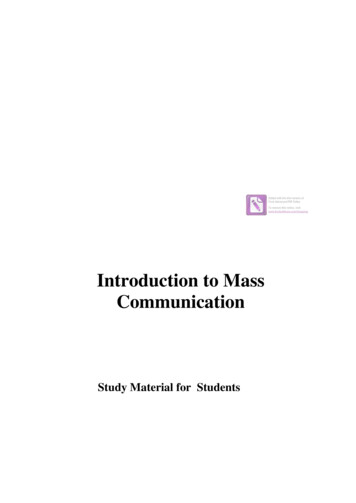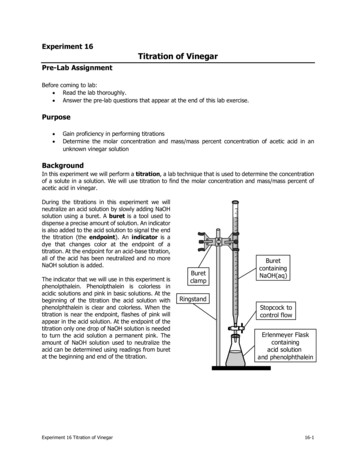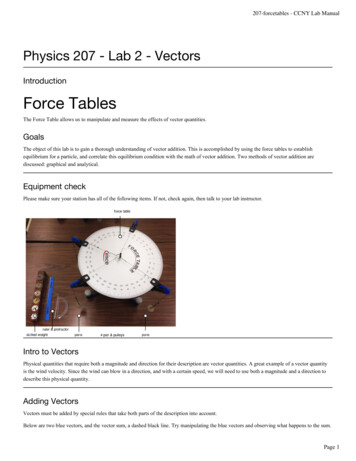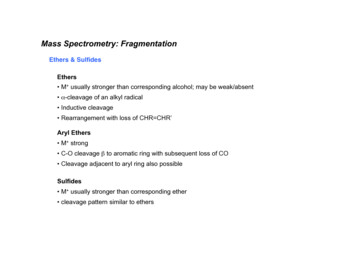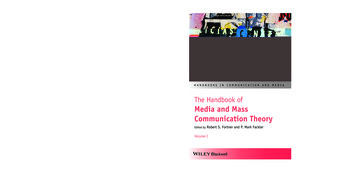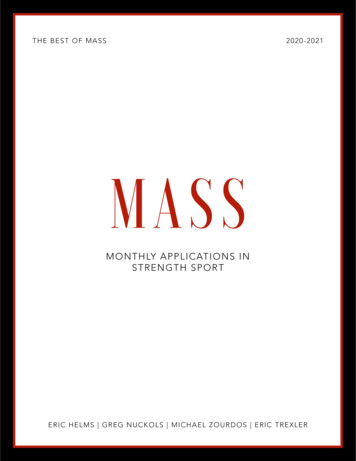
Transcription
T H E B E S T OF MASS202 0 - 2 0 2 1MASSM ONTHLY A PPL ICATIO N S INSTRE N G TH SPO R TE R I C H E LMS G R E G N UCK O LS MIC HAEL ZO URDO S ERIC T REXL E R
The ReviewersEric HelmsEric Helms is a coach, athlete, author, and educator. He is a coach for drug-free strength and physiquecompetitors at all levels as a part of team 3D Muscle Journey where he is also the Chief ScienceOfficer. Eric regularly publishes peer-reviewed articles in exercise science and nutrition journals onphysique and strength sport, in addition to contributing to the 3DMJ blog. He’s taught undergraduateand graduate-level nutrition and exercise science and speaks internationally at academic andcommercial conferences. He has a B.S. in fitness and wellness, an M.S. in exercise science, a secondMaster’s in sports nutrition, a Ph.D. in strength and conditioning, and is a research fellow for the SportsPerformance Research Institute New Zealand at Auckland University of Technology. Eric earned prostatus as a natural bodybuilder with the PNBA in 2011 and competes in numerous strength sports.Greg NuckolsGreg Nuckols has over a decade of experience under the bar and a B.S. in exercise and sportsscience. Greg earned his M.A. in exercise and sport science from the University of North Carolinaat Chapel Hill. He’s held three all-time world records in powerlifting in the 220lb and 242lb classes.He’s trained hundreds of athletes and regular folks, both online and in-person. He’s written for manyof the major magazines and websites in the fitness industry, including Men’s Health, Men’s Fitness,Muscle & Fitness, Bodybuilding.com, T-Nation, and Schwarzenegger.com. Furthermore, he’s had theopportunity to work with and learn from numerous record holders, champion athletes, and collegiateand professional strength and conditioning coaches through his previous job as Chief ContentDirector for Juggernaut Training Systems and current full-time work on StrongerByScience.com.Michael C. ZourdosMichael (Mike) C. Zourdos, Ph.D., CSCS, has specializations in strength and conditioning and skeletalmuscle physiology. He earned his Ph.D. in exercise physiology from The Florida State University (FSU)in 2012 under the guidance of Dr. Jeong-Su Kim. Prior to attending FSU, Mike received his B.S. inexercise science from Marietta College and M.S. in applied health physiology from Salisbury University.Mike served as the head powerlifting coach of FSU’s 2011 and 2012 state championship teams. Healso competes as a powerlifter in the USAPL, and among his best competition lifts is a 230kg (507lbs)raw squat at a body weight of 76kg. Mike owns the company Training Revolution, LLC., where he hascoached more than 100 lifters, including a USAPL open division national champion.Eric TrexlerEric Trexler is a pro natural bodybuilder and a sports nutrition researcher. Eric has a PhD in HumanMovement Science from UNC Chapel Hill, and has published dozens of peer-reviewed researchpapers on various exercise and nutrition strategies for getting bigger, stronger, and leaner. Inaddition, Eric has several years of University-level teaching experience, and has been involved incoaching since 2009. Eric is the Director of Education at Stronger By Science.2
Table of Contents6BY GR EG NUCKOL SImproving Muscle Growth by Individualizing TrainingVolumeIn a recent study, subjects trained one leg with standardized training volume (the samevolume for everyone), and one leg with individualized volume (a 20% increase abovetheir prior baseline). Individualized volume led to more quad growth, suggesting thatwe should be more concerned about manipulating training volume based on yourrecent history, rather than aiming to find one single “optimal” level of training volume foreveryone.15BY MI CHAEL C. ZOUR DOSTime to Reframe the Proximity to Failure ConversationIt’s time to stop asking if training a few reps shy of failure is okay, as I think we haveenough evidence to support this notion. Rather, it’s time to reframe the proximity tofailure conversation and ask, how far can we train from failure? It may be farther thanyou think.31BY ER I C HEL MSA Progression Framework for HypertrophyHypertrophy: It’s a goal listed next to strength, power, and muscular endurance in yourtextbook or professional manual, complete with ranges for each variable of training.What assumptions does this framework require? This article takes a “first principles”perspective on hypertrophy, using it to provide a model for progression.43BY ER I C T R EXL ERModest Glycogen Depletion May Impact LiftingPerformance More Than You ThinkSome fitness professionals have questioned the importance of dietary carbohydrate, giventhat resistance training only depletes 24-40% of muscle glycogen. New data suggest thatsmall reductions in muscle glycogen might have bigger performance impacts than oncethought. Read on to learn about some very important carbohydrate research.57BY GR EG NUCKOL SRibosome Biogenesis Influences Whether High VolumesCause More GrowthHigher volumes tend to lead to more muscle growth and larger strength gains, but noteveryone responds to higher volumes in the same way. A recent study found that peoplewho respond better to higher volumes may do so due to an increase in ribosomalcontent of their muscle fibers.3
69BY MI CHAEL C. ZOUR DOSPenalty: Reduction in Gains for InterferenceA new study showed that strength gains can still be made even with high amounts ofaerobic training. This article breaks down the recent data and provides a clear guide onhow you can implement cardio in a way that will have a minimal effect on your size andstrength.8398BY ER I C T R EXL ERProtein Distribution Matters, To An ExtentOne of the most common questions in the world of nutrition is, “How much proteinshould I eat, and when?” A new study adds some nuance to the conversation, andsuggests that protein distribution matters in some contexts. Read on to find out if you’remaximizing the impact of the protein in your diet.BY GR EG NUCKOL SFemales Fatigue Slower than Males Largely Due toDifferences in Blood FlowIt’s fairly common knowledge that female lifters are less fatigable in the gym than malelifters. However, that relationship is surprisingly nuanced, and it’s primarily driven by afactor most people don’t immediately suspect: blood flow.113BY MI CHAEL C. ZOUR DOSVIDEO: Volume CyclingSome evidence suggests that really high volumes are beneficial for muscle growth inshort-term studies. However, what works for eight weeks may not be advisable overthe long-term. This video examines the evidence for cycling volume and discusseshow this approach may be more sustainable than always performing really highvolumes.115BY ER I C HEL MSVIDEO: Translating Nutrition Guidelines to LifeImagine sitting at the dinner table on a holiday with your family. Someone looks atyou and says “I’ve gotten serious about lifting, do you have any nutrition advice?”If you told them “eat 1.6 to 2.2 grams of protein daily per kilogram of bodyweight”,they’d either think it was a joke, or they’d nod and smile, but nothing about theirnutrition habits would change. In this presentation, you’ll learn how to turn quantitativeguidelines into eating patterns.4
Letter from the ReviewersWelcome to the 2020-2021 “Best Of” issue of MASS! Whether this is thefirst time you’re getting a peek inside our research review or you’ve beensubscribed since day 1, we think you’ll love what you find in this specialedition of MASS.Since we launched MASS in April 2017, we’ve published 49 issues – that’s about465 articles and videos, 5,000 pages of content, 300 audio roundtable episodes, 1,000illustrative graphics, and 82 hours of video. We offer CEUs for NSCA and NASMand CECs for ACSM and ACE. As of April 2021, we have more than 4,300 activesubscribers. (Not a subscriber yet? Join here.)What you’ll find in these pages is a glimpse at some of our favorite content from thefourth year of MASS, but you can be confident that every issue is packed with rigorouslyexamined and visually stunning reviews of the research that’s most relevant to strengthand physique athletes, coaches, and enthusiasts.If you (or your clients) want to build muscle, get stronger, and/or drop fat as efficientlyand effectively as possible, MASS is for you. We know you want to stay on top of theresearch, but doing so can be time-consuming, expensive, and confusing. That’s why wedo all the heavy lifting for you and distill the most important findings into an easy-to-readmonthly digest.This free issue should give you an idea of what you can expect from MASS. In ourwritten pieces, we cover individualizing training volume, proximity to failure, aprogression framework for hypertrophy, glycogen depletion, ribosome biogenesis, theinterference effect, protein distribution, fatiguability of male vs. female lifters, and more.In our unique video content, Mike covers volume cycling, and Eric Helms translatesnutrition guidelines to life.Each issue will tackle new topics like these, keeping you up to date with the currentresearch and giving you a thorough understanding of the best science-based practices. Wehope you enjoy it, and we hope you’ll subscribe so you can stay on the cutting edge ofour field to get the best results possible for yourself or your clients.Thanks so much for reading.The MASS TeamEric Helms, Greg Nuckols, Mike Zourdos, and Eric Trexler5
Study Reviewed: Muscle Hypertrophy Response Is Affected by Previous ResistanceTraining Volume in Trained Individuals. Scarpelli et al. (2020)Improving Muscle Growth byIndividualizing Training VolumeBY GR EG N UCKO L SIn a recent study, subjects trained one leg with standardized trainingvolume (the same volume for everyone), and one leg with individualizedvolume (a 20% increase above their prior baseline). Individualizedvolume led to more quad growth, suggesting that we should be moreconcerned about manipulating training volume based on your recenthistory, rather than aiming to find one single “optimal” level of trainingvolume for everyone.6
KEY POINTS1. Over eight weeks, trained subjects trained one leg with 20% more weekly setsthan they’d been using in their training previously, and trained the other leg with22 sets per week, regardless of prior training volume.2. Subjects experienced significantly more quad growth, on average, in the leg thatunderwent a 20% volume increase, even though average volume ended up beingsimilar between conditions.3. When assigning training volume, it’s better to focus on gradually increasingvolume from one’s current baseline, rather than simply jumping to some level ofvolume that’s theoretically ideal for the average person.Imagine a scenario for me: We fast-forward 20 years in the future, and we nowhave enough data to accurately and precisely model the “inverted U” relationshipbetween training volume and muscle growth.It’s found that the Optimal( ) training volumeis 20 sets per muscle group per week. A client comes to you, having recently plateauedafter previously making solid gains on 8 setsper muscle group per week. Do you A) bumptheir volume up gradually and see how theyrespond, or do you B) move them straightfrom 8 sets per week to the Optimal( ) volume of 20 sets per week?To me, option A seems like a no-brainer. Population averages may or may not apply to anindividual, and this client’s baseline abilityto adapt to training stressors is heavily influenced by their recent training. “High volume”or “low volume” training aren’t fixed pointsacross all lifters, but are fluid constructs thatvary person-to-person, defined relative to eachindividual’s baseline training volumes. “Lowvolume,” “moderate volume,” and “high volume” don’t necessarily mean, say, 0-10, 11-20, and 20 sets per muscle group per week;I see them more like, “less volume than I’maccustomed to,” “about the same amount ofvolume I’m accustomed to,” and “considerably more volume than I’m accustomed to.”That’s not the type of thinking that generallyinforms research design, unfortunately. Thepresently reviewed study (1) is an exception.The researchers interviewed experienced lifters and asked them how many sets of quadtraining they performed per week. For eachsubject, one leg was assigned to an individualized condition in which volume for that legwas increased by 20% over their pre-studyvolume. For example, if someone had beendoing 5 sets of quad training per week, thenthat person started doing 6 sets; if they’d beendoing 40 sets, they started doing 48.The other leg was assigned to a standardizedcondition, which consisted of 22 sets for allsubjects. After 8 weeks of training, quadricepscross-sectional area (CSA) increased significantly more in the individualized conditionthan the standardized condition. Thus, when7
analyzing and assigning training volume, it’smore informative and productive to look atchanges relative to the individual’s traininghistory, instead of comparing their trainingvolume to some fixed reference point.Purpose and HypothesesPurposeThe purpose of this study was to compare thehypertrophic effects of training with a standardized (i.e. 22 sets per week) amount ofvolume versus an individualized ( 20% ofan individual’s previous volume) amount ofvolume.HypothesesThe authors hypothesized that individualizedvolume would lead to more muscle growththan standardized volume.Subjects and MethodsSubjectsThe subjects were 16 young males with anaverage of 5.1 years of resistance trainingexperience, regularly performing knee extensions and leg press.Experimental DesignThis study utilized a within-subject unilateral design. That means that for each subject,one leg was randomized into the standardized condition, with the other leg enteringthe individualized condition. Subjects trainedtwice per week for eight weeks, performing unilateral leg press followed by unilateral knee extensions. Volume for the standardized leg was fixed at 22 sets per week(based on the average weekly volume usedin an allegedly random sample of studies inthe literature), which I assume means 5-6 setsapiece, in each session, of unilateral leg pressand unilateral knee extensions per workout.Volume for the individualized leg was basedon each subject’s self-reported quad trainingvolume in the two weeks prior to the start ofthe study; the researchers increased weeklyvolume by 20% above baseline for the individualized leg on a per-subject basis. In bothconditions, all sets were taken to technicalfailure, and loads were adjusted so that thesubjects would reach the point of failure after8-12 reps per set. Subjects rested two minutesbetween sets.Like any longitudinal training study, testingwas performed before and after the trainingprogram. No strength outcomes were tested,so the only testing consisted of measuringquad CSA via ultrasound scans.FindingsQuadriceps CSA increased significantly morein the individualized condition than in thestandardized condition ( 9.9% vs. 6.2%; p 0.042; mean difference 1.08cm2; CI 0.042.11cm2). Furthermore, of the 16 subjects, 10had superior increases in quadriceps CSA inthe individualized condition compared to thestandardized condition that were larger thanthe typical measurement error of the ultrasound CSA assessments. Only 2 out of 16subjects had superior increases (in excess ofthe measurement error) in their leg assignedto the standardized condition. Hypertrophywas similar between conditions in the otherfour subjects.8
Muscle cross-sectional area increases from baseline to after 8 weeks resistance training25Changeis CSAÆCSA(%) (%)20151052.61 (CV)A0CSAIndividualized vs. Standardized (cm2)Figure 1B4.53.0StandardizedIndividualized1.50.8 (TE)0.0-0.8 (TE)-1.5-3.0-4.5A) Dashed line indicates2.61%A)indicates 1%B) Gray circles indicate whether the increases in CSA (cross-sectional area) obtained with the individualized protocol are greater than(above 0.8 typical error [TE]), smaller than (below -0.8 TE), or similar (between 0.8 and -0.8 TE) to those obtained with the standardized.Dashed line indicates the measurement typical error: 0.8cm2* significantly different from standardized (p 0.05)Both conditions completed similar volumeloads on average, but there were large differences on an individual basis. All subjectsincreased their volume load relative to baseline by approximately 20% in the individualized condition. In the standardized condition,changes in volume load from pre-trainingranged from a reduction of almost 50% to anincrease of 120%. Overall, 4 of the 16 subjects decreased their weekly set volume inthe standardized condition, and 8 out of 16subjects increased their set volume by 30%or more, meaning that only 4 subjects hadmodest ( 30%) increases in set volume.InterpretationThis study represents an important piece ofthe puzzle that’s been sorely missing fromthe resistance training literature. When study-ing the effects of training volume on musclegrowth, subjects tend to be assigned to differing volume conditions without any regardfor prior training history. If a study uses 10sets per week as a low-volume condition and20 sets per week as a high-volume condition,the 10-set condition may feel like super highvolume and be very difficult to recover fromfor someone who had previously been training with a volume of just 5 sets per week forthe target muscle group; conversely, 20 setsper week could feel like a deload for someone accustomed to 30 sets per week. Effectslike that should theoretically wash out withrandom group allocation if the sample sizeis sufficient, but it still introduces a sourceof heterogeneity into the results of the study.More importantly, we can claim that increasing set volume should increase musclegrowth, but training studies aren’t actually9
Figure 2(A) Volume load, (B) average volume load progression, and (C) weekly training volumedesigned to directly support or refute thatidea, since training volume assigned to eachparticipant doesn’t consider the lifter’s previous training volume.A major strength of this study was that thevolume ended up being similar in both conditions. If volume differed significantly between conditions, one could then claim thatmaybe the individualized condition just ledto more growth because volume was higher(or because volume was lower, thus positingthat that other condition led to overreaching).Since both conditions led to similar trainingvolume on average, this study supports theidea that optimal training volume is highlyindividualized and probably based, in part,on individual training histories. I think that’sa more productive way to approach the problem than simply trying to discover the single number that represents the Optimal( )weekly set volume. If, for example, we had10 times as much research and we couldpinpoint 15 sets per week as the weekly setvolume associated with the largest averagegains in the literature, I still don’t think thatwould be incredibly helpful. If you’ve beenmaking gains with 5 sets per week, triplingyour training volume overnight probablyisn’t a great idea, and if you’ve been making gains with 30 sets per week, cutting yourtraining volume in half also probably isn’t theticket to improved hypertrophy outcomes.However, if we had baseline training data inall of those studies in this theoretical futuremeta-analysis, and we could determine thata 10% increase in volume every six weekswas associated with the largest gains, I dothink that information would be highly generalizable for most trainees. It may not behelpful to someone who’s already pushingthe boundary of overtraining, but it wouldprobably be useful for the vast majority oflifters. That’s not to say that the current bodyof literature is without merit; learning moreabout the levels of volume that produce thebest outcomes, on average, can still serve asa useful sanity check. For example, if we find10
out that 15 sets per week is Optimal( ) andyou’re not making progress with 5 sets perweek, you could surmise that you could probably benefit from increasing your volume, orif you’re not making gains and constantlyfeel worn down with 30 sets per week, youcould surmise that you probably don’t needto be afraid of knocking your volume down.However, I do think that assigning volumebased on subjects’ habitual training volume isa more informative study design, and it moreclosely resembles how I approach things asa coach. It also makes better sense biologically. We know that people habituate to priorstimuli, that sufficient physiological stressorsdrive adaptation, and that stressors can be excessive for an organism to adapt positivelyto (relative to the stressors they’re currentlyhabituated to). Manipulating training volumerelative to each subject’s established baselinerespects what we know about how peopleadapt to training stimuli, whereas giving halfyour subjects X volume per week and halfyour subjects 2X volume per week does not.In other words, the approach used in the current study respects what we’ve learned in thepast century about how organisms respond tostress, while the standard approach for studying the impact of volume on muscle growthseemingly pretends like that body of knowledge doesn’t exist.The results of this study raise an interestingpossibility, which we’ve discussed in MASSbefore: volume cycling. If periodic increases in weekly set volume reliably produceincreases in muscle growth, that’s all welland good, but there must be a limit to thatapproach. If you compound 20% increas-es in set volume over time, even if you onlyincrease set volume every 6 months, you’lleventually wind up with completely unmanageable training volume. There must be afinite amount of training that people can respond positively to. However, we also knowthat lifters can decrease training volume considerably – by at least two-thirds – and notlose muscle (2). Thus, we could gradually increase set volume over time until it becomesunmanageable, reduce training volume to establish a new baseline, and repeat the process(4). You could do this with all muscle groupssimultaneously, or (more realistically), with ahandful of muscle groups at a time. Currently, the concept of volume cycling is used “inthe trenches,” but it only has indirect theoretical support in the literature. I’d love to see itstudied more directly.There’s one more thing I’d like to clear up aboutthe results of the current study: We know thata 20% increase in training volume above thesubjects’ pre-training baseline worked well,but we can’t claim (as the authors of the studydo) that a 20% increase in training volume“maximize[s] muscle hypertrophic response intrained individuals.” There’s only one way wecould ascertain the optimal (average) increasein training volume to maximize hypertrophy:We would need a study to compare differentvolume increases. If a study tested increasesof, say, 10%, 20%, and 30%, and 20% cameout on top, then we could claim that, on average, a 20% increase in volume maximizeshypertrophy over a matter of months. There’sa second way to test this idea using the datafrom the present study, though it would not beable to establish causation. You could compare11
AS WITH ALL METRICS,WE SHOULDN’T EXPECTRELATIVE INCREASES INTRAINING VOLUME TO BEPERFECTLY PREDICTIVEOF HYPERTROPHY.the relationship between volume changes inthe standardized group and hypertrophic results relative to the individualized condition. Inother words (sorry, long sentence incoming),if there was a clear inverse parabolic relationship, where subjects who decreased their volume in the standardized condition and subjectswho massively increased their volume in thestandardized condition both experienced wayless growth in their quad assigned to the standardized condition than in their quad assignedto the individualized condition, but subjectswho increased their weekly volume by a modest amount in the standardized condition experienced similar growth in both legs, that wouldthen suggest that modest increases in trainingvolume are, in fact, optimal for hypertrophy.This method wouldn’t be able to pinpoint 20%as optimal, but it could provide additional evidence that somewhere in the 20% range (giveor take 10-20%) is optimal. On the contrary, ifthe peak of the inverted parabola was closer to50%, that may suggest that the current studywas too conservative, and larger increases involume are actually optimal for hypertrophy,in the short-to-medium-term.As with all metrics, however, we shouldn’texpect relative increases in training volumeto be perfectly predictive of hypertrophy. Insupport of the notion that volume increasesare only weakly associated with hypertrophy, a recent training study by Aube and colleagues (3) performed exploratory analysesto see what factors differentiated high andlower hypertrophic responders. They splittheir group into tertiles based on hypertrophy response (the lowest tertile experiencedvirtually no growth, and the highest tertile experienced the most growth), and theyfound that their lowest tertile had increasedtheir training volume by just 1.8 6.7 setsper muscle group per week (that was the difference between their pre-study training volume and the volume they were assigned forthe study), their middle tertile had increasedtheir training volume by 4.3 9.3 sets perweek, and their highest tertile had increasedtheir training volume by 6.6 12.4 sets perweek. Those differences represented relativeincreases of 12%, 33%, and 58%. At first,CHANGE IN TRAININGVOLUME WAS MOREPREDICTIVE OF RESULTSTHAN ACTUAL TRAININGVOLUME WAS.12
APPLICATION AND TAKEAWAYSSlightly increasing your training volume above its current level will probably help youbuild more muscle, as long as you aren’t already straining your ability to recover fromand adapt positively to training. Theoretically, cycling training volume over fairly long timescales (e.g. multiple months) may lead to more muscle growth than sticking with a fixedlevel of training volume over time.that looks like a clear linear relationship,suggesting that larger increases in volumeare predictive of more hypertrophy, and thatthe 20% increase in the present study was tooconservative. However, we can’t overlookthose enormous standard deviations. For thesubjects in the top tertile (the subjects that experienced the most hypertrophy), an increaseof 6.6 12.4 sets per week suggests thatseveral of the top-responding subjects likelydecreased their training volume, and severalincreased their training volume by more than100%. In that same study, the subjects’ actualtraining volume in sets per week during thestudy protocol also wasn’t predictive of hypertrophy. Changes in leg fat-free mass andquad muscle thickness were virtually identical between groups performing 12, 18, or24 sets per week. Change in training volumewas more predictive of results than actualtraining volume was, but neither metric wasstrongly associated with hypertrophy. So,I still believe that research should be morefocused on finding ideal changes in trainingvolume from subjects’ pre-training baselinesrather than in finding a single, magical, absolute training volume, but we shouldn’t expectthat either metric will be anywhere close toperfect for predicting muscle growth.Next StepsI’d love to see a longitudinal training studywhere subjects are assigned differing levelsof volume increases from baseline. To covera wide swath of possibilities, it could includefour groups, with groups increasing weekly set volume by 0%, 25%, 50%, and 100%to cover a wide range of possibilities (5). Iwould anticipate that either a 25% or a 50%increase would yield the best results out ofthose four options. That would help us establish a general area where we should be looking in future studies.13
References1. Scarpelli MC, Nóbrega SR, Santanielo N, Alvarez IF, Otoboni GB, Ugrinowitsch C,Libardi CA. Muscle Hypertrophy Response Is Affected by Previous Resistance TrainingVolume in Trained Individuals. J Strength Cond Res. 2020 Feb 27.2. Bickel CS, Cross JM, Bamman MM. Exercise dosing to retain resistance trainingadaptations in young and older adults. Med Sci Sports Exerc. 2011 Jul;43(7):1177-87.3. Aube D, Wadhi T, Rauch J, Anand A, Barakat C, Pearson J, Bradshaw J, Zazzo S,Ugrinowitsch C, De Souza EO. Progressive Resistance Training Volume: Effects onMuscle Thickness, Mass, and Strength Adaptations in Resistance-Trained Individuals. JStrength Cond Res. 2020 Feb 13.4. Note that the process of increasing volume doesn’t have to be super rapid. If you’remaking progress at a given level of volume, it may be worthwhile to ride it out until youstop making progress, rather than being greedy and proactively ramping your volume upprematurely. That’s a decision you can make for yourself, though.5. Another option would be to simply increase volume by, say, 1, 3, 5, and 10 sets per week.Percent increases may be problematic if some of the subjects were already training withreally high volumes. I strongly assume a 50% increase from 6 to 9 sets per week wouldgo swimmingly, but a 50% increase from 40 to 60 sets per week would probably be wayoverboard.
Study Reviewed: Effect of Resistance Training to Muscle Failure Vs. Non-Failure on Strength,Hypertrophy and Muscle Architecture in Trained Individuals. Santanielo et al. (2020)Time to Reframe the Proximity toFailure ConversationBY MICHAEL C. ZOURDOSIt’s time to stop asking if training a few reps shy of failure is okay,as I think we have enough evidence to support this notion. Rather,it’s time to reframe the proximity to failure conversation and ask,how far can we train from failure? It may be farther than you think.15
KEY POINTS1. This study had 14 trained men train the unilateral leg press and leg extension twiceper week. Subjects trained one leg to failure and were instructed to stop sets on theother leg before they reached failure.2. On average, subjects stopped sets in the non-failure leg with about 1.5 repetitionsin reserve. There were no signific
of the major magazines and websites in the fitness industry, including Men’s Health, Men’s Fitness, Muscle & Fitness, Bodybuilding.com, T-Nation, and Schwarzenegger.com. Furthermor



